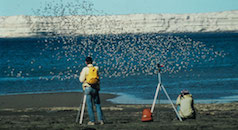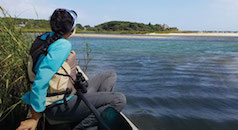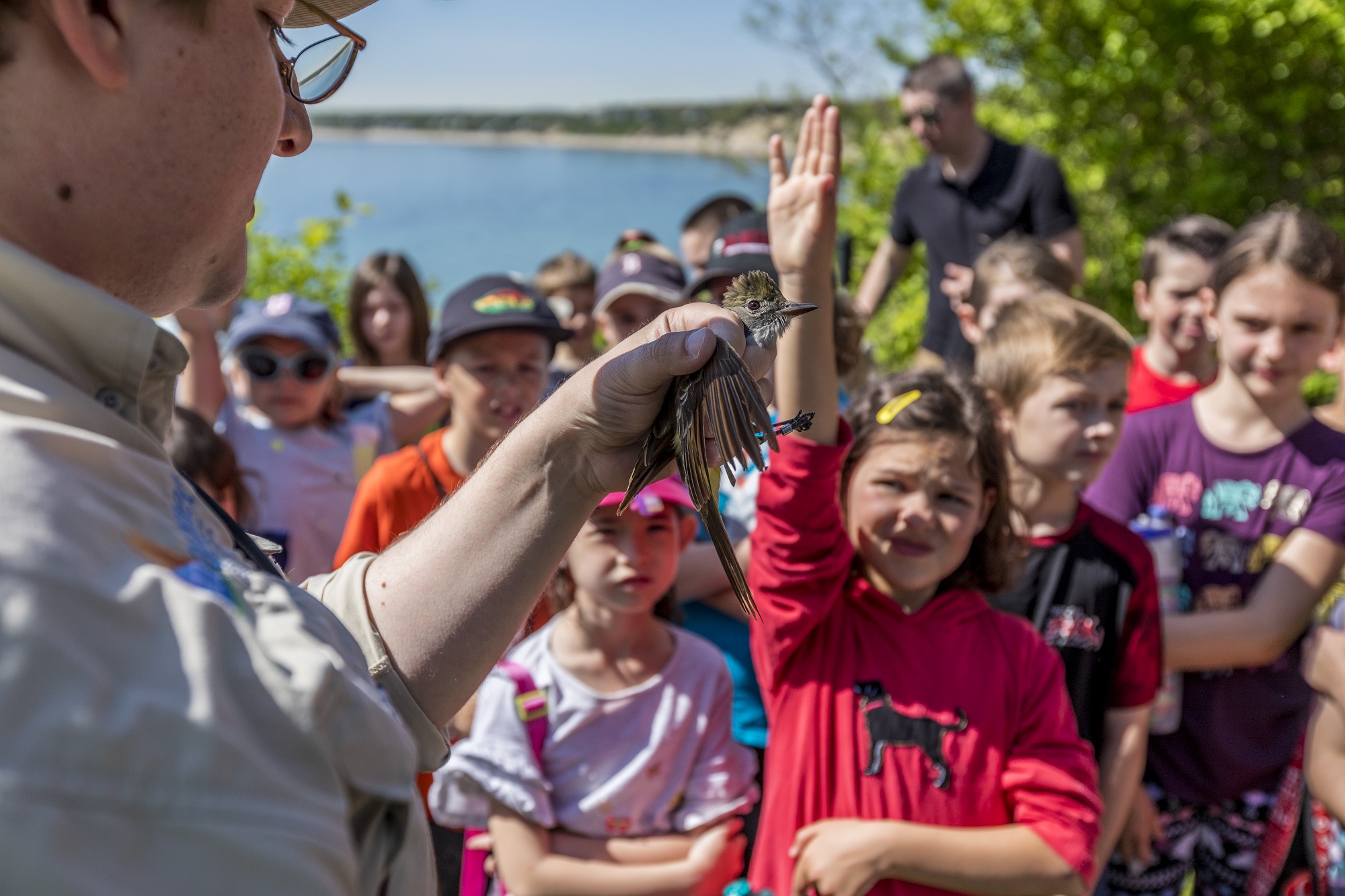Search Results

Setting the stage for fisheries recoveries
On a sunny Saturday in spring 2019, several hundred people gathered to watch the spectacle of alewives making their way up a tributary of the Bagaduce River to Pierce’s Pond in Penobscot, a community on the shores of Maine’s Penobscot Bay. Kids and adults marveled at the powerful instinct that drives this small fish to work its way upstream. Ospreys and eagles circled overhead, looking for an opportunity to snatch a meal from the teeming waters. But this lively natural event hasn’t always been so, and there is still a lot of potential for conservation progress. Manomet and partners like the Maine Center for Coastal Fisheries (MCCF) are working closely with local communities in Downeast Maine and other nonprofits like...
Whimbrel Migration: Summer 2020 Update
Whimbrel migration is in full swing! From July through late September, Whimbrel migrate southward from their Arctic and sub-Arctic breeding grounds and some spend up to a month with us along our coast. While in Massachusetts, Whimbrel spend almost all of their time in the saltmarshes feeding on fiddler crabs—an important staple in their diet. After replenishing their energy reserves, Whimbrel in Massachusetts will typically make a non-stop, trans-oceanic flight to their wintering grounds in the Caribbean Islands or all the way to the north coast of South America. Manomet’s Shorebird Recovery team is excited to share an update on what “our” satellite-transmittered Whimbrel have been up to over the last few months. These birds’ stories continue to help us...
Manomet wins awards to support work diversifying fisheries through aquaculture
The Gulf of Maine is warming faster than 99% of the world’s oceans. The very foundations of the ecosystem are changing, causing new species to move in and others to leave. To maintain the livelihoods of New England fishers and healthy, delicious, and sustainable seafood options, it’s important for humans to adapt to the changing ecosystem. Manomet has recently received multiple grants for one project that is a potential diversification strategy for shellfish harvesters hit hard by historically low soft-shell clam landings, and for oyster farmers looking to hedge against a rapidly increasing supply of oysters in Maine and across the Northeast. In August, Manomet was awarded a grant from The Northeast Sustainable Agriculture Research and Education (SARE) Program to...
Is a soft-shell green crab industry viable in New England?
NOAA Fisheries awards Manomet $267,440 to investigate Brunswick, ME – September 11, 2018 – Manomet has been awarded a grant of $267,440 by the NOAA Saltonstall-Kennedy Grant Program to expand work to develop a lucrative green crab fishery in New England and provide a new source of economic opportunity for fishers and coastal communities. The grant will be used to implement long-term green crab population monitoring, explore new pathways to developing the soft-shell green crab fishery, increase marketing and outreach efforts, and begin to determine the economic viability of a soft-shell fishery. The European green crab was brought to the U.S. in the early 1800’s. As the Gulf of Maine warms, this invasive species is thriving. It is a voracious...
Shellfish Aquaculture and Management
Shellfish landings in Maine are at historic lows—due to the effects of climate change and an increase in predators like the invasive European green crab (Carcinus maenas) and the milky ribbon worm (Cerebratulus lacteus). Manomet is working with shellfish harvesters and aquaculturists on a suite of aquaculture projects to diversify clam, oyster and quahog harvests. Soft-shell clam aquaculture Soft-shell clams (Mya arenaria) are the second most valuable fishery in Maine—valued at about $18 million in 2014. Unfortunately, soft-shell clam landings in many coastal communities have reached historic lows. A soft-shell clam farm involves seeding sub-productive intertidal flats with hatchery-raised clams and then covering the seeded area with plastic netting to protect the clams from one of its main predators, the...
A little fish with a big impact
By: Anne Hayden, Program Manager, Sustainable Economies Program More and more people are feeling the love for a little fish with a big impact, the alewife. The Downeast Fisheries Partnership (DFP), coordinated by Manomet’s Anne Hayden, is making the case for alewife restoration in eastern Maine’s rivers and streams. These fish are commercially harvested and a local delicacy, but they are also the base of river and coastal food webs and a key component of the Partnership’s focus on restoring cod, haddock, and other species. The spectacle of adult alewives surging upstream each spring draws fishermen and wildlife enthusiasts (as well as osprey and other predators), but it is the return of millions of juvenile alewives back downstream to...
Climate change and coastal communities
By: Eric Walberg, Senior Program Leader, Climate Services Program Excerpted from the Nature-based infrastructure: The multiple benefits approach to coastal resiliency article in Manomet’s Partnerships for Sustainability FALL 2016/WINTER 2017 Magazine Climate change underscores the need for a green infrastructure-based approach to conservation planning. Coastlines around the world will be dramatically reshaped by sea level rise. Processes that have been set in motion by a warming planet, such as thermal expansion of sea water and melting of the Greenland and Antarctic ice sheets, will continue to unfold for centuries to come. In the immediate future, sea level rise will continue to exacerbate vulnerability to storm surge flooding by providing a higher launch point for coastal storms. The...
Students get muddy for science
Creating a sustainable food system is one of Manomet’s key goals and our Clam Farm Project’s work to restore the soft-shell clam fishery in Maine will help to make that goal a reality. Funded by a $288,000 grant from NOAA Saltonstall-Kennedy program, Manomet’s project helps coastal towns in Maine learn about soft-shell clam farming and will launch five new farms in Maine. Manomet and our partners have been busy this fall starting a new clam farm and getting students out to the Heal Eddy clam flat for some muddy (and educational) fun! Soft-shell clams are the second most valuable fishery in Maine—valued at about $18 million in 2014. Unfortunately, soft-shell clam landings in many coastal communities have declined in recent...
Maine Soft-shell Clam Aquaculture Project
Maine’s $18M soft-shell clam (Mya arenaria) industry is in trouble. The Gulf of Maine has been warming faster than 99% of the world’s oceans. Warmer waters have allowed populations of the invasive European green crab to increase along Maine’s coast and decimate the soft-shell clam resource in some towns. Because the crabs prey on younger clams, once the commercial-size clams are harvested, there are no juveniles to replace them. The fishery collapses. Shellfish harvesters are looking for a solution to keep clamming a viable option for future generations of Mainers. WHAT WE DO To address this growing concern Manomet partnered with clammer Chris Warner in 2012 to develop Maine’s first commercial soft-shell farm off the coast of...
4th Quarter Development Update
Annual Fund Thank you for helping us reach our goal—and then some! You Did It! Thank you for your dedicated support and for helping us not only reach, but exceed our FY 2015 Annual Fund goal by $60,000, for a total of more than $960,000. We depend on our supporters more than anything else. Because of the generous contributions of our many donors we continue our work towards a sustainable future. You make it possible for Manomet to grow and change with the demands of the times, and all of us at Manomet want you to know how grateful we are to have you on our team. If you haven't given to Manomet this year, please...



